Entrepreneurship and Small Business Management Report, BTEC HND
VerifiedAdded on 2021/02/19
|11
|2722
|393
Report
AI Summary
This report provides a comprehensive analysis of entrepreneurship and small business management, fulfilling the requirements of a BTEC HND assignment. The report begins with an introduction defining entrepreneurship and exploring its scope and typology, differentiating entrepreneurs from intrapreneurs, and providing examples of various ventures. It then delves into a critical examination of different entrepreneurial ventures, including small, scalable startup, large, and social enterprises, highlighting their similarities and dissimilarities in terms of purpose, capital investment, and risk-taking. Furthermore, the report explores the impact of small businesses on the economy, referencing relevant data and statistics to demonstrate their contribution to job creation, income generation, and innovation. The report concludes with a summary of the key findings and references used throughout the analysis. The report also analyses the traits, motivational drivers of success entrepreneur and how their background and experiences has influenced them in positive and negative manner.

Entrepreneurship and
Small Business
Management
Small Business
Management
Paraphrase This Document
Need a fresh take? Get an instant paraphrase of this document with our AI Paraphraser
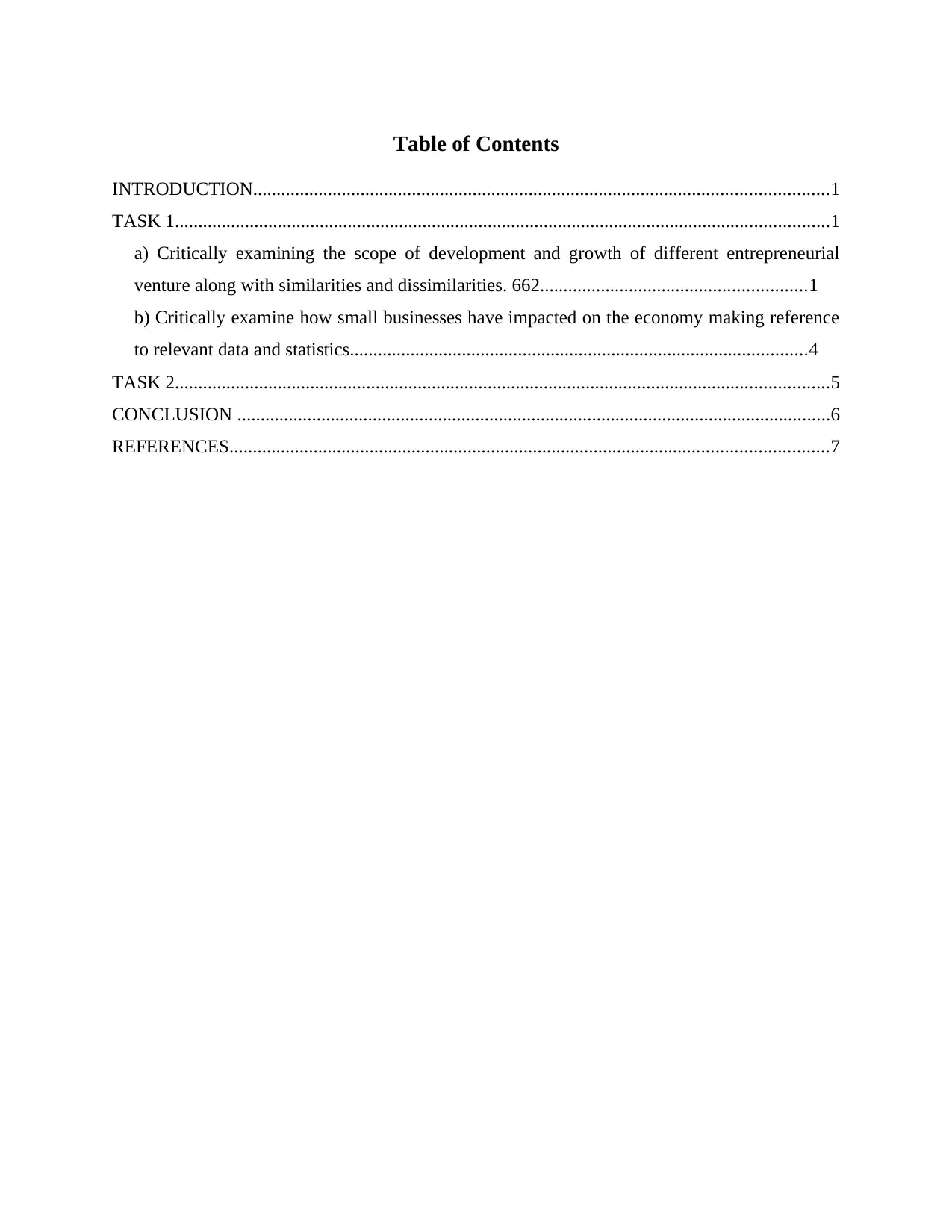
Table of Contents
INTRODUCTION...........................................................................................................................1
TASK 1............................................................................................................................................1
a) Critically examining the scope of development and growth of different entrepreneurial
venture along with similarities and dissimilarities. 662.........................................................1
b) Critically examine how small businesses have impacted on the economy making reference
to relevant data and statistics..................................................................................................4
TASK 2............................................................................................................................................5
CONCLUSION ...............................................................................................................................6
REFERENCES................................................................................................................................7
INTRODUCTION...........................................................................................................................1
TASK 1............................................................................................................................................1
a) Critically examining the scope of development and growth of different entrepreneurial
venture along with similarities and dissimilarities. 662.........................................................1
b) Critically examine how small businesses have impacted on the economy making reference
to relevant data and statistics..................................................................................................4
TASK 2............................................................................................................................................5
CONCLUSION ...............................................................................................................................6
REFERENCES................................................................................................................................7

⊘ This is a preview!⊘
Do you want full access?
Subscribe today to unlock all pages.

Trusted by 1+ million students worldwide
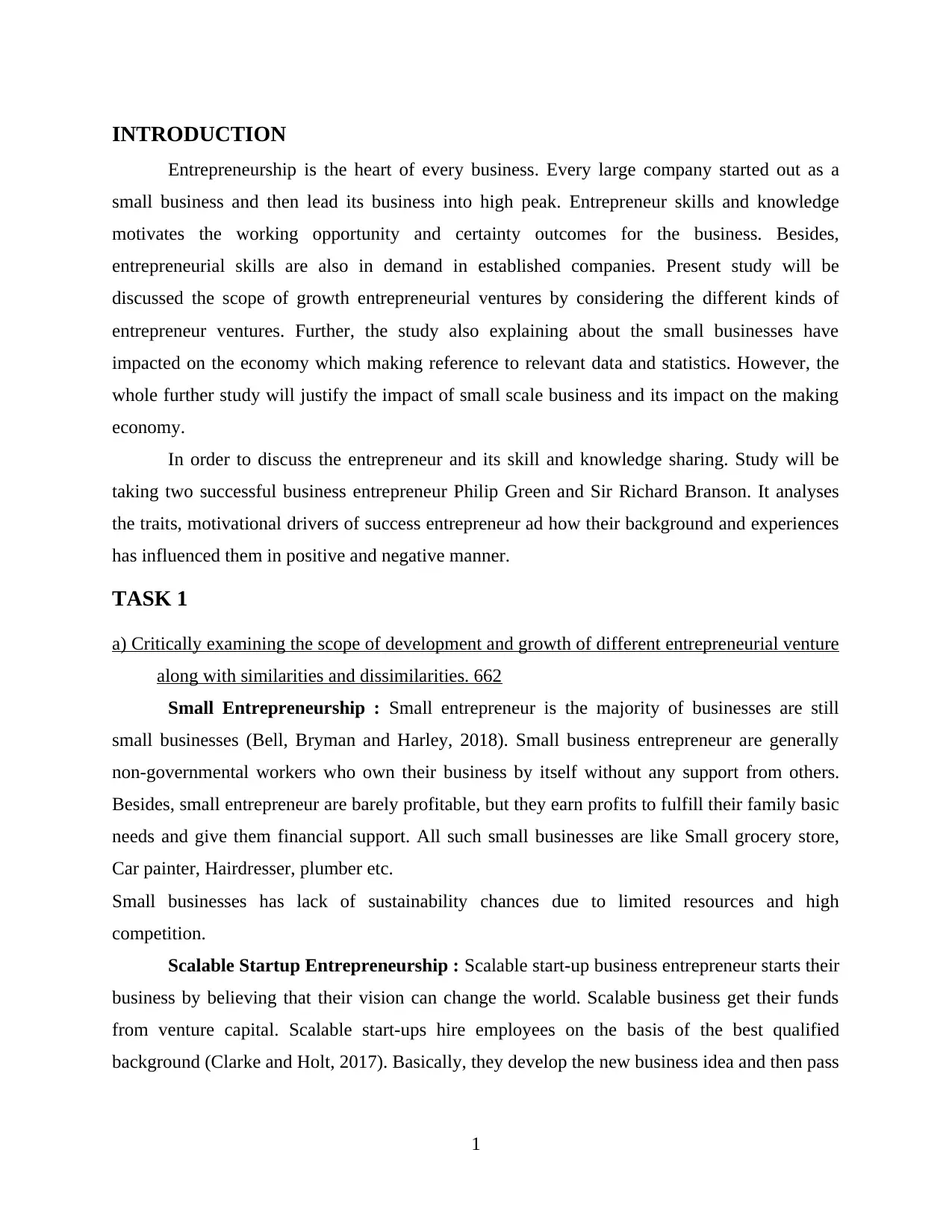
INTRODUCTION
Entrepreneurship is the heart of every business. Every large company started out as a
small business and then lead its business into high peak. Entrepreneur skills and knowledge
motivates the working opportunity and certainty outcomes for the business. Besides,
entrepreneurial skills are also in demand in established companies. Present study will be
discussed the scope of growth entrepreneurial ventures by considering the different kinds of
entrepreneur ventures. Further, the study also explaining about the small businesses have
impacted on the economy which making reference to relevant data and statistics. However, the
whole further study will justify the impact of small scale business and its impact on the making
economy.
In order to discuss the entrepreneur and its skill and knowledge sharing. Study will be
taking two successful business entrepreneur Philip Green and Sir Richard Branson. It analyses
the traits, motivational drivers of success entrepreneur ad how their background and experiences
has influenced them in positive and negative manner.
TASK 1
a) Critically examining the scope of development and growth of different entrepreneurial venture
along with similarities and dissimilarities. 662
Small Entrepreneurship : Small entrepreneur is the majority of businesses are still
small businesses (Bell, Bryman and Harley, 2018). Small business entrepreneur are generally
non-governmental workers who own their business by itself without any support from others.
Besides, small entrepreneur are barely profitable, but they earn profits to fulfill their family basic
needs and give them financial support. All such small businesses are like Small grocery store,
Car painter, Hairdresser, plumber etc.
Small businesses has lack of sustainability chances due to limited resources and high
competition.
Scalable Startup Entrepreneurship : Scalable start-up business entrepreneur starts their
business by believing that their vision can change the world. Scalable business get their funds
from venture capital. Scalable start-ups hire employees on the basis of the best qualified
background (Clarke and Holt, 2017). Basically, they develop the new business idea and then pass
1
Entrepreneurship is the heart of every business. Every large company started out as a
small business and then lead its business into high peak. Entrepreneur skills and knowledge
motivates the working opportunity and certainty outcomes for the business. Besides,
entrepreneurial skills are also in demand in established companies. Present study will be
discussed the scope of growth entrepreneurial ventures by considering the different kinds of
entrepreneur ventures. Further, the study also explaining about the small businesses have
impacted on the economy which making reference to relevant data and statistics. However, the
whole further study will justify the impact of small scale business and its impact on the making
economy.
In order to discuss the entrepreneur and its skill and knowledge sharing. Study will be
taking two successful business entrepreneur Philip Green and Sir Richard Branson. It analyses
the traits, motivational drivers of success entrepreneur ad how their background and experiences
has influenced them in positive and negative manner.
TASK 1
a) Critically examining the scope of development and growth of different entrepreneurial venture
along with similarities and dissimilarities. 662
Small Entrepreneurship : Small entrepreneur is the majority of businesses are still
small businesses (Bell, Bryman and Harley, 2018). Small business entrepreneur are generally
non-governmental workers who own their business by itself without any support from others.
Besides, small entrepreneur are barely profitable, but they earn profits to fulfill their family basic
needs and give them financial support. All such small businesses are like Small grocery store,
Car painter, Hairdresser, plumber etc.
Small businesses has lack of sustainability chances due to limited resources and high
competition.
Scalable Startup Entrepreneurship : Scalable start-up business entrepreneur starts their
business by believing that their vision can change the world. Scalable business get their funds
from venture capital. Scalable start-ups hire employees on the basis of the best qualified
background (Clarke and Holt, 2017). Basically, they develop the new business idea and then pass
1
Paraphrase This Document
Need a fresh take? Get an instant paraphrase of this document with our AI Paraphraser
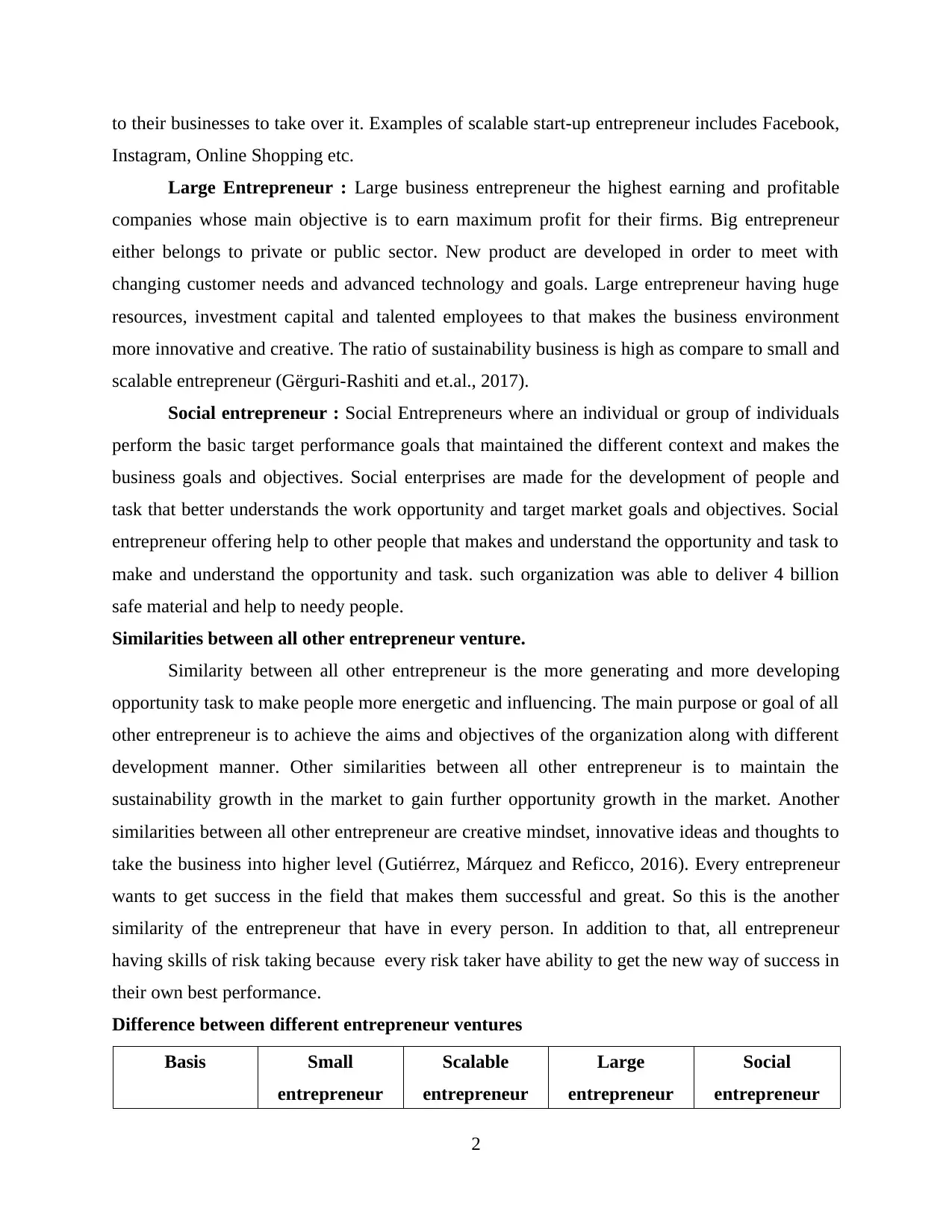
to their businesses to take over it. Examples of scalable start-up entrepreneur includes Facebook,
Instagram, Online Shopping etc.
Large Entrepreneur : Large business entrepreneur the highest earning and profitable
companies whose main objective is to earn maximum profit for their firms. Big entrepreneur
either belongs to private or public sector. New product are developed in order to meet with
changing customer needs and advanced technology and goals. Large entrepreneur having huge
resources, investment capital and talented employees to that makes the business environment
more innovative and creative. The ratio of sustainability business is high as compare to small and
scalable entrepreneur (Gërguri‐Rashiti and et.al., 2017).
Social entrepreneur : Social Entrepreneurs where an individual or group of individuals
perform the basic target performance goals that maintained the different context and makes the
business goals and objectives. Social enterprises are made for the development of people and
task that better understands the work opportunity and target market goals and objectives. Social
entrepreneur offering help to other people that makes and understand the opportunity and task to
make and understand the opportunity and task. such organization was able to deliver 4 billion
safe material and help to needy people.
Similarities between all other entrepreneur venture.
Similarity between all other entrepreneur is the more generating and more developing
opportunity task to make people more energetic and influencing. The main purpose or goal of all
other entrepreneur is to achieve the aims and objectives of the organization along with different
development manner. Other similarities between all other entrepreneur is to maintain the
sustainability growth in the market to gain further opportunity growth in the market. Another
similarities between all other entrepreneur are creative mindset, innovative ideas and thoughts to
take the business into higher level (Gutiérrez, Márquez and Reficco, 2016). Every entrepreneur
wants to get success in the field that makes them successful and great. So this is the another
similarity of the entrepreneur that have in every person. In addition to that, all entrepreneur
having skills of risk taking because every risk taker have ability to get the new way of success in
their own best performance.
Difference between different entrepreneur ventures
Basis Small
entrepreneur
Scalable
entrepreneur
Large
entrepreneur
Social
entrepreneur
2
Instagram, Online Shopping etc.
Large Entrepreneur : Large business entrepreneur the highest earning and profitable
companies whose main objective is to earn maximum profit for their firms. Big entrepreneur
either belongs to private or public sector. New product are developed in order to meet with
changing customer needs and advanced technology and goals. Large entrepreneur having huge
resources, investment capital and talented employees to that makes the business environment
more innovative and creative. The ratio of sustainability business is high as compare to small and
scalable entrepreneur (Gërguri‐Rashiti and et.al., 2017).
Social entrepreneur : Social Entrepreneurs where an individual or group of individuals
perform the basic target performance goals that maintained the different context and makes the
business goals and objectives. Social enterprises are made for the development of people and
task that better understands the work opportunity and target market goals and objectives. Social
entrepreneur offering help to other people that makes and understand the opportunity and task to
make and understand the opportunity and task. such organization was able to deliver 4 billion
safe material and help to needy people.
Similarities between all other entrepreneur venture.
Similarity between all other entrepreneur is the more generating and more developing
opportunity task to make people more energetic and influencing. The main purpose or goal of all
other entrepreneur is to achieve the aims and objectives of the organization along with different
development manner. Other similarities between all other entrepreneur is to maintain the
sustainability growth in the market to gain further opportunity growth in the market. Another
similarities between all other entrepreneur are creative mindset, innovative ideas and thoughts to
take the business into higher level (Gutiérrez, Márquez and Reficco, 2016). Every entrepreneur
wants to get success in the field that makes them successful and great. So this is the another
similarity of the entrepreneur that have in every person. In addition to that, all entrepreneur
having skills of risk taking because every risk taker have ability to get the new way of success in
their own best performance.
Difference between different entrepreneur ventures
Basis Small
entrepreneur
Scalable
entrepreneur
Large
entrepreneur
Social
entrepreneur
2
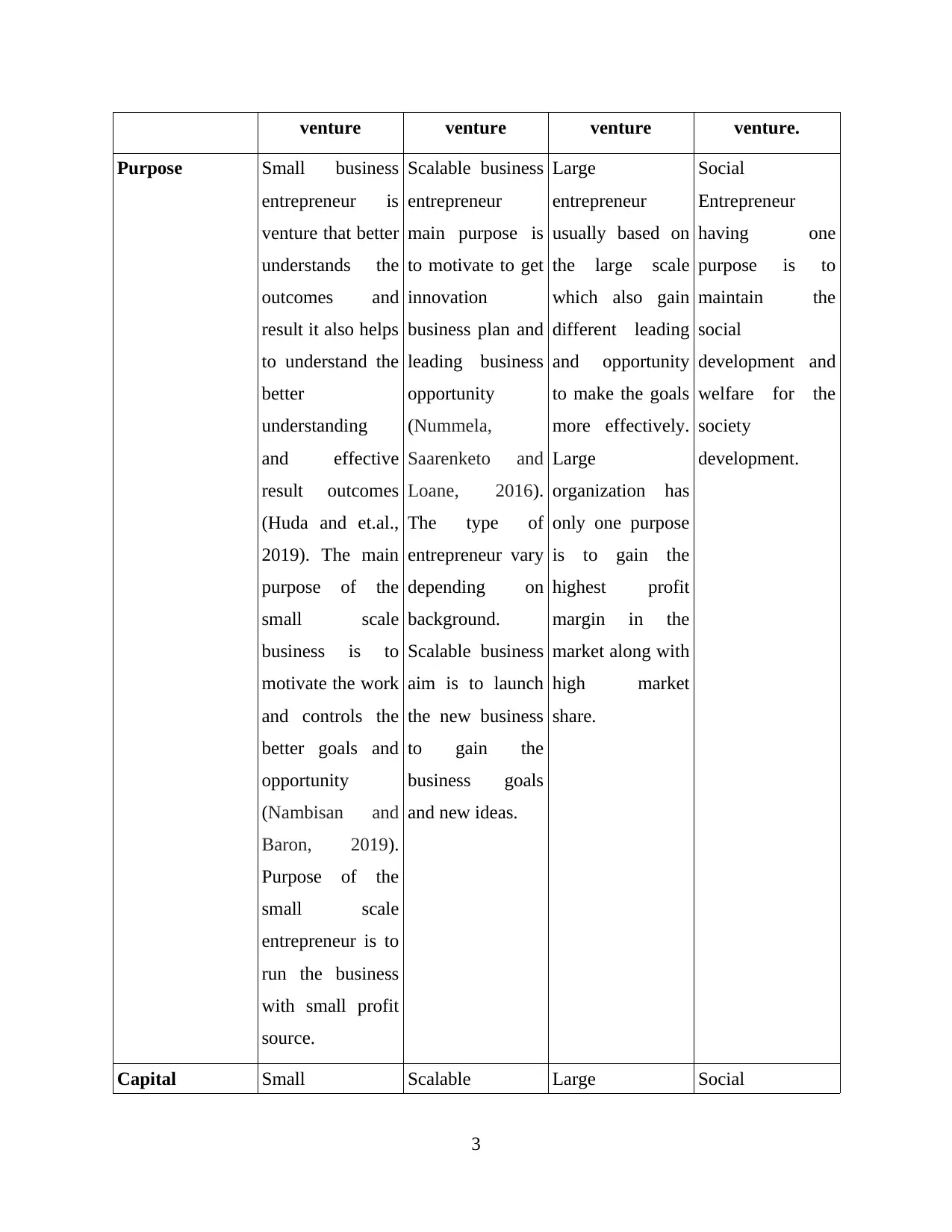
venture venture venture venture.
Purpose Small business
entrepreneur is
venture that better
understands the
outcomes and
result it also helps
to understand the
better
understanding
and effective
result outcomes
(Huda and et.al.,
2019). The main
purpose of the
small scale
business is to
motivate the work
and controls the
better goals and
opportunity
(Nambisan and
Baron, 2019).
Purpose of the
small scale
entrepreneur is to
run the business
with small profit
source.
Scalable business
entrepreneur
main purpose is
to motivate to get
innovation
business plan and
leading business
opportunity
(Nummela,
Saarenketo and
Loane, 2016).
The type of
entrepreneur vary
depending on
background.
Scalable business
aim is to launch
the new business
to gain the
business goals
and new ideas.
Large
entrepreneur
usually based on
the large scale
which also gain
different leading
and opportunity
to make the goals
more effectively.
Large
organization has
only one purpose
is to gain the
highest profit
margin in the
market along with
high market
share.
Social
Entrepreneur
having one
purpose is to
maintain the
social
development and
welfare for the
society
development.
Capital Small Scalable Large Social
3
Purpose Small business
entrepreneur is
venture that better
understands the
outcomes and
result it also helps
to understand the
better
understanding
and effective
result outcomes
(Huda and et.al.,
2019). The main
purpose of the
small scale
business is to
motivate the work
and controls the
better goals and
opportunity
(Nambisan and
Baron, 2019).
Purpose of the
small scale
entrepreneur is to
run the business
with small profit
source.
Scalable business
entrepreneur
main purpose is
to motivate to get
innovation
business plan and
leading business
opportunity
(Nummela,
Saarenketo and
Loane, 2016).
The type of
entrepreneur vary
depending on
background.
Scalable business
aim is to launch
the new business
to gain the
business goals
and new ideas.
Large
entrepreneur
usually based on
the large scale
which also gain
different leading
and opportunity
to make the goals
more effectively.
Large
organization has
only one purpose
is to gain the
highest profit
margin in the
market along with
high market
share.
Social
Entrepreneur
having one
purpose is to
maintain the
social
development and
welfare for the
society
development.
Capital Small Scalable Large Social
3
⊘ This is a preview!⊘
Do you want full access?
Subscribe today to unlock all pages.

Trusted by 1+ million students worldwide
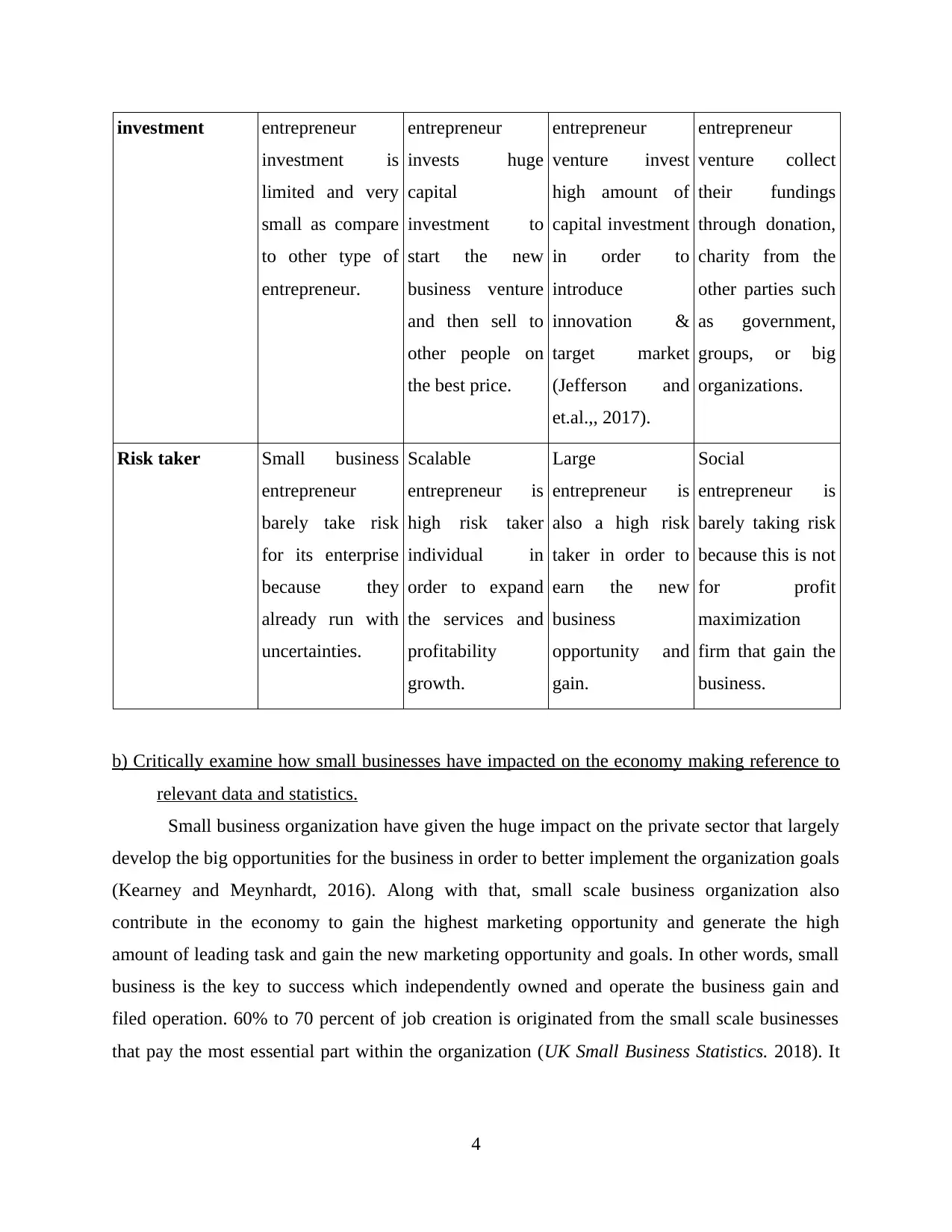
investment entrepreneur
investment is
limited and very
small as compare
to other type of
entrepreneur.
entrepreneur
invests huge
capital
investment to
start the new
business venture
and then sell to
other people on
the best price.
entrepreneur
venture invest
high amount of
capital investment
in order to
introduce
innovation &
target market
(Jefferson and
et.al.,, 2017).
entrepreneur
venture collect
their fundings
through donation,
charity from the
other parties such
as government,
groups, or big
organizations.
Risk taker Small business
entrepreneur
barely take risk
for its enterprise
because they
already run with
uncertainties.
Scalable
entrepreneur is
high risk taker
individual in
order to expand
the services and
profitability
growth.
Large
entrepreneur is
also a high risk
taker in order to
earn the new
business
opportunity and
gain.
Social
entrepreneur is
barely taking risk
because this is not
for profit
maximization
firm that gain the
business.
b) Critically examine how small businesses have impacted on the economy making reference to
relevant data and statistics.
Small business organization have given the huge impact on the private sector that largely
develop the big opportunities for the business in order to better implement the organization goals
(Kearney and Meynhardt, 2016). Along with that, small scale business organization also
contribute in the economy to gain the highest marketing opportunity and generate the high
amount of leading task and gain the new marketing opportunity and goals. In other words, small
business is the key to success which independently owned and operate the business gain and
filed operation. 60% to 70 percent of job creation is originated from the small scale businesses
that pay the most essential part within the organization (UK Small Business Statistics. 2018). It
4
investment is
limited and very
small as compare
to other type of
entrepreneur.
entrepreneur
invests huge
capital
investment to
start the new
business venture
and then sell to
other people on
the best price.
entrepreneur
venture invest
high amount of
capital investment
in order to
introduce
innovation &
target market
(Jefferson and
et.al.,, 2017).
entrepreneur
venture collect
their fundings
through donation,
charity from the
other parties such
as government,
groups, or big
organizations.
Risk taker Small business
entrepreneur
barely take risk
for its enterprise
because they
already run with
uncertainties.
Scalable
entrepreneur is
high risk taker
individual in
order to expand
the services and
profitability
growth.
Large
entrepreneur is
also a high risk
taker in order to
earn the new
business
opportunity and
gain.
Social
entrepreneur is
barely taking risk
because this is not
for profit
maximization
firm that gain the
business.
b) Critically examine how small businesses have impacted on the economy making reference to
relevant data and statistics.
Small business organization have given the huge impact on the private sector that largely
develop the big opportunities for the business in order to better implement the organization goals
(Kearney and Meynhardt, 2016). Along with that, small scale business organization also
contribute in the economy to gain the highest marketing opportunity and generate the high
amount of leading task and gain the new marketing opportunity and goals. In other words, small
business is the key to success which independently owned and operate the business gain and
filed operation. 60% to 70 percent of job creation is originated from the small scale businesses
that pay the most essential part within the organization (UK Small Business Statistics. 2018). It
4
Paraphrase This Document
Need a fresh take? Get an instant paraphrase of this document with our AI Paraphraser
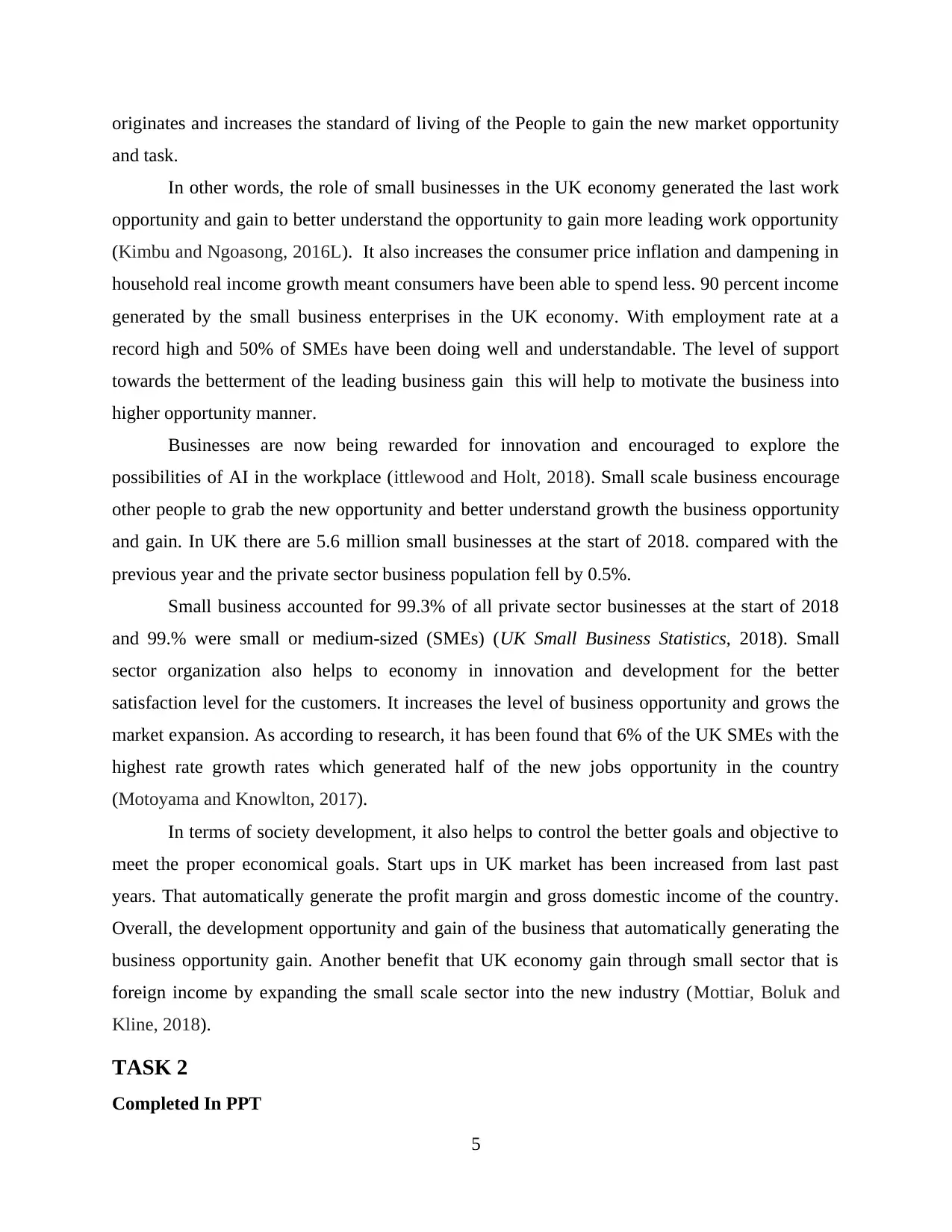
originates and increases the standard of living of the People to gain the new market opportunity
and task.
In other words, the role of small businesses in the UK economy generated the last work
opportunity and gain to better understand the opportunity to gain more leading work opportunity
(Kimbu and Ngoasong, 2016L). It also increases the consumer price inflation and dampening in
household real income growth meant consumers have been able to spend less. 90 percent income
generated by the small business enterprises in the UK economy. With employment rate at a
record high and 50% of SMEs have been doing well and understandable. The level of support
towards the betterment of the leading business gain this will help to motivate the business into
higher opportunity manner.
Businesses are now being rewarded for innovation and encouraged to explore the
possibilities of AI in the workplace (ittlewood and Holt, 2018). Small scale business encourage
other people to grab the new opportunity and better understand growth the business opportunity
and gain. In UK there are 5.6 million small businesses at the start of 2018. compared with the
previous year and the private sector business population fell by 0.5%.
Small business accounted for 99.3% of all private sector businesses at the start of 2018
and 99.% were small or medium-sized (SMEs) (UK Small Business Statistics, 2018). Small
sector organization also helps to economy in innovation and development for the better
satisfaction level for the customers. It increases the level of business opportunity and grows the
market expansion. As according to research, it has been found that 6% of the UK SMEs with the
highest rate growth rates which generated half of the new jobs opportunity in the country
(Motoyama and Knowlton, 2017).
In terms of society development, it also helps to control the better goals and objective to
meet the proper economical goals. Start ups in UK market has been increased from last past
years. That automatically generate the profit margin and gross domestic income of the country.
Overall, the development opportunity and gain of the business that automatically generating the
business opportunity gain. Another benefit that UK economy gain through small sector that is
foreign income by expanding the small scale sector into the new industry (Mottiar, Boluk and
Kline, 2018).
TASK 2
Completed In PPT
5
and task.
In other words, the role of small businesses in the UK economy generated the last work
opportunity and gain to better understand the opportunity to gain more leading work opportunity
(Kimbu and Ngoasong, 2016L). It also increases the consumer price inflation and dampening in
household real income growth meant consumers have been able to spend less. 90 percent income
generated by the small business enterprises in the UK economy. With employment rate at a
record high and 50% of SMEs have been doing well and understandable. The level of support
towards the betterment of the leading business gain this will help to motivate the business into
higher opportunity manner.
Businesses are now being rewarded for innovation and encouraged to explore the
possibilities of AI in the workplace (ittlewood and Holt, 2018). Small scale business encourage
other people to grab the new opportunity and better understand growth the business opportunity
and gain. In UK there are 5.6 million small businesses at the start of 2018. compared with the
previous year and the private sector business population fell by 0.5%.
Small business accounted for 99.3% of all private sector businesses at the start of 2018
and 99.% were small or medium-sized (SMEs) (UK Small Business Statistics, 2018). Small
sector organization also helps to economy in innovation and development for the better
satisfaction level for the customers. It increases the level of business opportunity and grows the
market expansion. As according to research, it has been found that 6% of the UK SMEs with the
highest rate growth rates which generated half of the new jobs opportunity in the country
(Motoyama and Knowlton, 2017).
In terms of society development, it also helps to control the better goals and objective to
meet the proper economical goals. Start ups in UK market has been increased from last past
years. That automatically generate the profit margin and gross domestic income of the country.
Overall, the development opportunity and gain of the business that automatically generating the
business opportunity gain. Another benefit that UK economy gain through small sector that is
foreign income by expanding the small scale sector into the new industry (Mottiar, Boluk and
Kline, 2018).
TASK 2
Completed In PPT
5
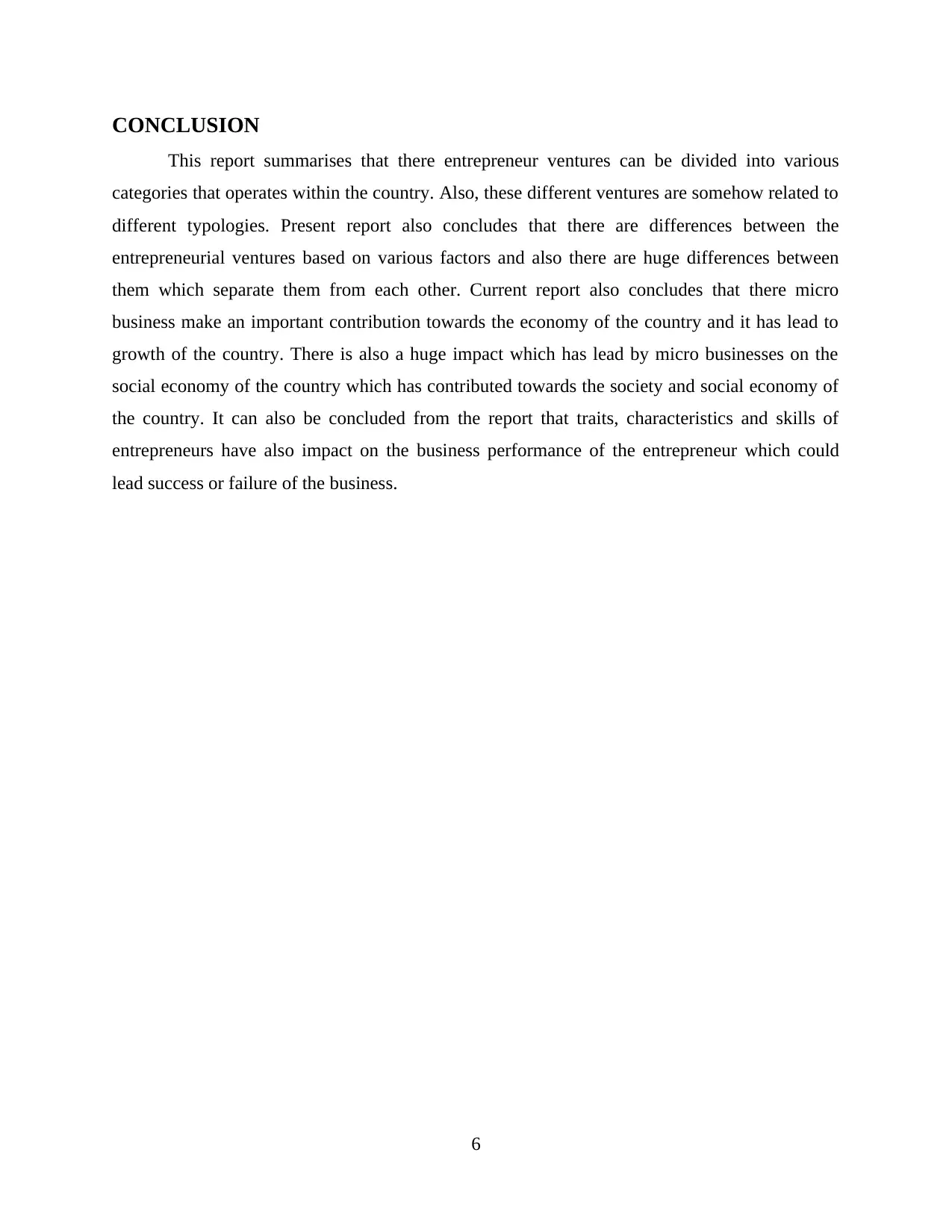
CONCLUSION
This report summarises that there entrepreneur ventures can be divided into various
categories that operates within the country. Also, these different ventures are somehow related to
different typologies. Present report also concludes that there are differences between the
entrepreneurial ventures based on various factors and also there are huge differences between
them which separate them from each other. Current report also concludes that there micro
business make an important contribution towards the economy of the country and it has lead to
growth of the country. There is also a huge impact which has lead by micro businesses on the
social economy of the country which has contributed towards the society and social economy of
the country. It can also be concluded from the report that traits, characteristics and skills of
entrepreneurs have also impact on the business performance of the entrepreneur which could
lead success or failure of the business.
6
This report summarises that there entrepreneur ventures can be divided into various
categories that operates within the country. Also, these different ventures are somehow related to
different typologies. Present report also concludes that there are differences between the
entrepreneurial ventures based on various factors and also there are huge differences between
them which separate them from each other. Current report also concludes that there micro
business make an important contribution towards the economy of the country and it has lead to
growth of the country. There is also a huge impact which has lead by micro businesses on the
social economy of the country which has contributed towards the society and social economy of
the country. It can also be concluded from the report that traits, characteristics and skills of
entrepreneurs have also impact on the business performance of the entrepreneur which could
lead success or failure of the business.
6
⊘ This is a preview!⊘
Do you want full access?
Subscribe today to unlock all pages.

Trusted by 1+ million students worldwide
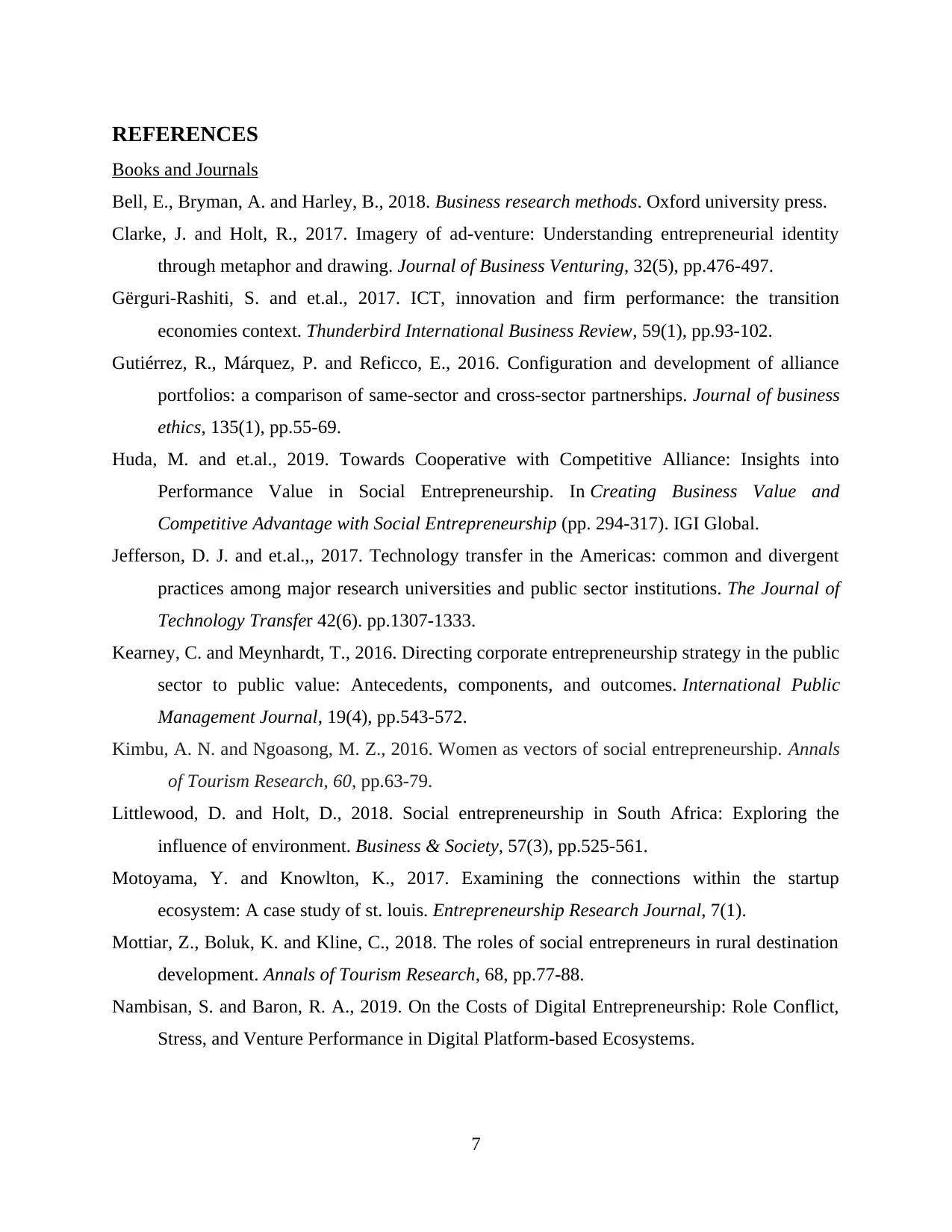
REFERENCES
Books and Journals
Bell, E., Bryman, A. and Harley, B., 2018. Business research methods. Oxford university press.
Clarke, J. and Holt, R., 2017. Imagery of ad-venture: Understanding entrepreneurial identity
through metaphor and drawing. Journal of Business Venturing, 32(5), pp.476-497.
Gërguri‐Rashiti, S. and et.al., 2017. ICT, innovation and firm performance: the transition
economies context. Thunderbird International Business Review, 59(1), pp.93-102.
Gutiérrez, R., Márquez, P. and Reficco, E., 2016. Configuration and development of alliance
portfolios: a comparison of same-sector and cross-sector partnerships. Journal of business
ethics, 135(1), pp.55-69.
Huda, M. and et.al., 2019. Towards Cooperative with Competitive Alliance: Insights into
Performance Value in Social Entrepreneurship. In Creating Business Value and
Competitive Advantage with Social Entrepreneurship (pp. 294-317). IGI Global.
Jefferson, D. J. and et.al.,, 2017. Technology transfer in the Americas: common and divergent
practices among major research universities and public sector institutions. The Journal of
Technology Transfer 42(6). pp.1307-1333.
Kearney, C. and Meynhardt, T., 2016. Directing corporate entrepreneurship strategy in the public
sector to public value: Antecedents, components, and outcomes. International Public
Management Journal, 19(4), pp.543-572.
Kimbu, A. N. and Ngoasong, M. Z., 2016. Women as vectors of social entrepreneurship. Annals
of Tourism Research, 60, pp.63-79.
Littlewood, D. and Holt, D., 2018. Social entrepreneurship in South Africa: Exploring the
influence of environment. Business & Society, 57(3), pp.525-561.
Motoyama, Y. and Knowlton, K., 2017. Examining the connections within the startup
ecosystem: A case study of st. louis. Entrepreneurship Research Journal, 7(1).
Mottiar, Z., Boluk, K. and Kline, C., 2018. The roles of social entrepreneurs in rural destination
development. Annals of Tourism Research, 68, pp.77-88.
Nambisan, S. and Baron, R. A., 2019. On the Costs of Digital Entrepreneurship: Role Conflict,
Stress, and Venture Performance in Digital Platform-based Ecosystems.
7
Books and Journals
Bell, E., Bryman, A. and Harley, B., 2018. Business research methods. Oxford university press.
Clarke, J. and Holt, R., 2017. Imagery of ad-venture: Understanding entrepreneurial identity
through metaphor and drawing. Journal of Business Venturing, 32(5), pp.476-497.
Gërguri‐Rashiti, S. and et.al., 2017. ICT, innovation and firm performance: the transition
economies context. Thunderbird International Business Review, 59(1), pp.93-102.
Gutiérrez, R., Márquez, P. and Reficco, E., 2016. Configuration and development of alliance
portfolios: a comparison of same-sector and cross-sector partnerships. Journal of business
ethics, 135(1), pp.55-69.
Huda, M. and et.al., 2019. Towards Cooperative with Competitive Alliance: Insights into
Performance Value in Social Entrepreneurship. In Creating Business Value and
Competitive Advantage with Social Entrepreneurship (pp. 294-317). IGI Global.
Jefferson, D. J. and et.al.,, 2017. Technology transfer in the Americas: common and divergent
practices among major research universities and public sector institutions. The Journal of
Technology Transfer 42(6). pp.1307-1333.
Kearney, C. and Meynhardt, T., 2016. Directing corporate entrepreneurship strategy in the public
sector to public value: Antecedents, components, and outcomes. International Public
Management Journal, 19(4), pp.543-572.
Kimbu, A. N. and Ngoasong, M. Z., 2016. Women as vectors of social entrepreneurship. Annals
of Tourism Research, 60, pp.63-79.
Littlewood, D. and Holt, D., 2018. Social entrepreneurship in South Africa: Exploring the
influence of environment. Business & Society, 57(3), pp.525-561.
Motoyama, Y. and Knowlton, K., 2017. Examining the connections within the startup
ecosystem: A case study of st. louis. Entrepreneurship Research Journal, 7(1).
Mottiar, Z., Boluk, K. and Kline, C., 2018. The roles of social entrepreneurs in rural destination
development. Annals of Tourism Research, 68, pp.77-88.
Nambisan, S. and Baron, R. A., 2019. On the Costs of Digital Entrepreneurship: Role Conflict,
Stress, and Venture Performance in Digital Platform-based Ecosystems.
7
Paraphrase This Document
Need a fresh take? Get an instant paraphrase of this document with our AI Paraphraser
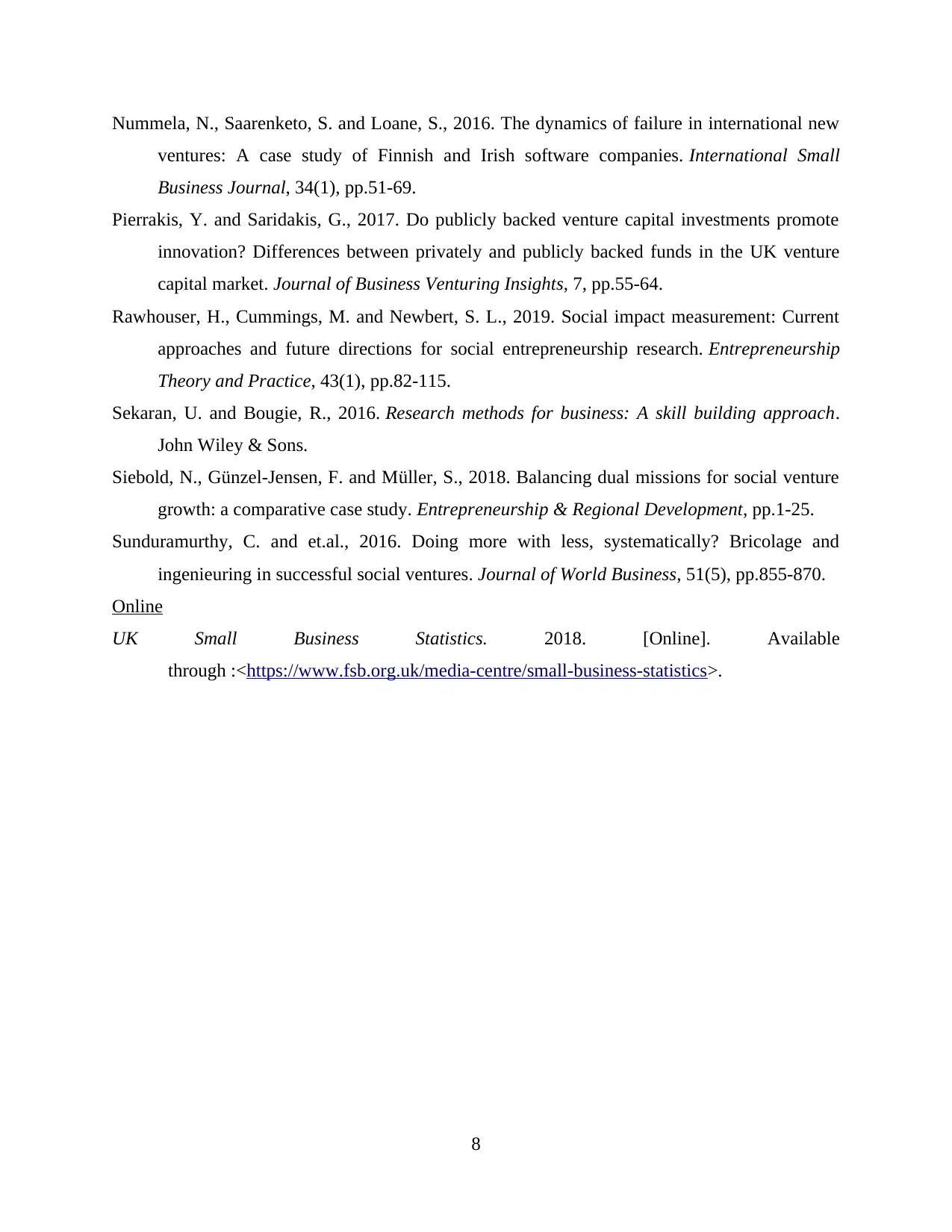
Nummela, N., Saarenketo, S. and Loane, S., 2016. The dynamics of failure in international new
ventures: A case study of Finnish and Irish software companies. International Small
Business Journal, 34(1), pp.51-69.
Pierrakis, Y. and Saridakis, G., 2017. Do publicly backed venture capital investments promote
innovation? Differences between privately and publicly backed funds in the UK venture
capital market. Journal of Business Venturing Insights, 7, pp.55-64.
Rawhouser, H., Cummings, M. and Newbert, S. L., 2019. Social impact measurement: Current
approaches and future directions for social entrepreneurship research. Entrepreneurship
Theory and Practice, 43(1), pp.82-115.
Sekaran, U. and Bougie, R., 2016. Research methods for business: A skill building approach.
John Wiley & Sons.
Siebold, N., Günzel-Jensen, F. and Mü ller, S., 2018. Balancing dual missions for social venture
growth: a comparative case study. Entrepreneurship & Regional Development, pp.1-25.
Sunduramurthy, C. and et.al., 2016. Doing more with less, systematically? Bricolage and
ingenieuring in successful social ventures. Journal of World Business, 51(5), pp.855-870.
Online
UK Small Business Statistics. 2018. [Online]. Available
through :<https://www.fsb.org.uk/media-centre/small-business-statistics>.
8
ventures: A case study of Finnish and Irish software companies. International Small
Business Journal, 34(1), pp.51-69.
Pierrakis, Y. and Saridakis, G., 2017. Do publicly backed venture capital investments promote
innovation? Differences between privately and publicly backed funds in the UK venture
capital market. Journal of Business Venturing Insights, 7, pp.55-64.
Rawhouser, H., Cummings, M. and Newbert, S. L., 2019. Social impact measurement: Current
approaches and future directions for social entrepreneurship research. Entrepreneurship
Theory and Practice, 43(1), pp.82-115.
Sekaran, U. and Bougie, R., 2016. Research methods for business: A skill building approach.
John Wiley & Sons.
Siebold, N., Günzel-Jensen, F. and Mü ller, S., 2018. Balancing dual missions for social venture
growth: a comparative case study. Entrepreneurship & Regional Development, pp.1-25.
Sunduramurthy, C. and et.al., 2016. Doing more with less, systematically? Bricolage and
ingenieuring in successful social ventures. Journal of World Business, 51(5), pp.855-870.
Online
UK Small Business Statistics. 2018. [Online]. Available
through :<https://www.fsb.org.uk/media-centre/small-business-statistics>.
8
1 out of 11
Related Documents
Your All-in-One AI-Powered Toolkit for Academic Success.
+13062052269
info@desklib.com
Available 24*7 on WhatsApp / Email
![[object Object]](/_next/static/media/star-bottom.7253800d.svg)
Unlock your academic potential
Copyright © 2020–2025 A2Z Services. All Rights Reserved. Developed and managed by ZUCOL.




